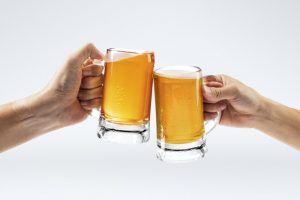In a 31 gal. Barrels of craft beer there is 250-16 oz. Cans of beer with labels explaining the attributes of the beer. The trick then becomes ensuring the messaging sells the beer! In that lies the science behind label styles.
A Label is data on the packaging designed to encourage the trial, purchase, and determine a whole.
“If it does not sell, it’s not creative,” David above Ogilvy. Ogilvy was a known advertising governor from London who touched Manhattan. He was a robust soul of victimization analysis to reduce risk in the sales method. Labels, as a sales tool for craft beer, maybe a hotbed of opportunity for pushing the boundaries of power in labels; after all, labels do appear to push the boundaries of design. “To get the results and sales that you are when, you need to stand out, be unique, and give creatively,” explains Creative Agency.
Labels are needed by law, so that the white space on a label, when legal needs are met, can be approached as a free advertising canvas that, if done creatively, can drive sales. Yes, ubiquitous designs (when targeted on the look and feel) drive sales and accurate data. However, the saloon may be a single destination; labels are universal (grocery stores, events, restaurants, Total Wine… ).
Let’s scrutinize effective label advertising primarily based upon parameters of sound analysis results. We frequently say we’d better be lucky than sensible. However, the truth is, luck isn’t a reliable factor in generating trials and sales.
Understanding the buyer isn’t only concerning demographic market analysis; it’s concerning generating trials, conversions, and loyalty. Competition and growth still have a great deal to try to do with full awareness and obtaining the buyer to undertake a brewery. Some recent analysis reportable by The Packaging faculty shows that sixty-fifth of shoppers for craft beer expect to launch new beers, and the label drives a part of the unique beer trial expertise.
Interestingly, biometric analysis versus qualitative surveys indicates shoppers are mainly unaware of what drives their selections to shop for a product. The Abundance of what goes into a purchase call is determined by our subconscious experiences. A choice to shop for a brand new craft beer is usually created inside a split-second of seeing the brewage label on a shelf, as one will or in an exceedingly multi-pack.
Based on the analysis conducted on craft brewage marketing presented at the 2020 Craft brewage Conference reportable in Package InSight and CODO style, label designs modify time as shopper tastes, attitudes, and designs modify. However, we tend to see that almost all inheritance brewage holes don’t match modification label styles due to disapproval issues and historic brand recognition.
Even the wine trade is currently rethinking the importance of labels in the scientific discipline of commercial wine. One example is obtainable by David Schuemann of CF Napa whole and design. “We are in an exceedingly Millennial-driven market and there has been a movement (in labels) toward a lot of modernness and therefore the quiet avant-garde visual cues you go along with U.S. wines; not such a lot with European wines.”
If you scrutinize labels these days in craft beer, they run the gambit-Dark pictures or perhaps bizarre characters, minimalist graphics, splashy, pop art, use of photography, textures, flippant, etc.; there appears not to be an assemblage for label designs. For example, compare two craft beer labels, the primary I outline as austere (Pliny the Elder-a river production IPA). The second may be an artificial avant-garde label ($60 Nachos-produced by Hoof-hearted Brewing); they’re opposites in style philosophy. Nonetheless, each is fortunate.
Whatever approach a still takes relative to packaging analysis, minimizing risk in the sales method involves surveys, focus teams, and biometric results. Victimization digitally created by taking a look at sample labels, written on self-adhesive material, then applied to a will, will represent the beginnings of analysis.
Biometric analysis maybe a tiny lot of concern; however, it will add depth to the helpful try.
A feature of the biometric study by Package InSight concerning craft beverages was to outline; however, eye movements will show that beer labels resonate (positively and negatively) with shoppers. However, the critical objective is to induce the buyer to choose up the instrumentality and skim the story concerning the brewery. Some analysis shows that if a shopper handles the packaging, it leads to AN eightieth likelihood the merchandise is purchased.
So why are there numerous approaches to styles? Dr Hurley-Associate prof at Clemson University and founding father of The Packaging faculty, says, “You need to show a discrepancy to command attention.” The trends currently for labels are contradictory. For example, craft labels feature critters, unorthodox styles, bright colours, artificial fonts, monotones, tattoo style art, and counter-culture art. At the opposite extreme, some good brewage labels are unit minimalist; nearly stark. As AN aside, there is a superfluity of label format choices. As an example, there’s shrink-wrap, digital print on will, self-adhesive, and paper. Change is constant, and fortunately, our craft is versatile and may move quickly to deal with what appeals to shoppers.
I have named the Package InSight “Craft beer Biometric Study” because it uses only 1 of the biometric measurements (eye movement) in shopper product choice. However, it will show the enticement labels and shelf placement has on generating new product trials. Most shoppers don’t have a preconceived notion of a selected beer they’ll purchase once getting into a store.
Whether a craft beer is a longtime whole, or a brand new vogue being developed, the biometric analysis will take away a great deal of risk in disapproval and sales, not accessible only through victimization surveys. Following dynamic analysis will facilitate craft beer firms to produce and re-enforce a whole and drive sales. Biometrics and qualitative research are best explained as–real-time versus psychological feature feel.
On their website, Package InSight, has an intensive library of biometric and anecdotal analysis on what influences shoppers in choosing craft brewed. Surprisingly, some findings indicate that even our appreciation for a most popular style is/was influenced by factors solely discovered by biometric victimization techniques. (IPA’s and Stouts were highly purchased designs during this analysis.)
Using qualitative shopper responses (question and answer surveys) employed in isolation will expose the still to false conclusions. There are shortcomings to all or any analysis strategies; except for optimum results, they have to be employed in conjunction with only one technique. “Relying on anecdotal responses might not be honest input, those respondents are not dishonest however rather they can’t recall subconscious impressions,” says Dr. Hurley.
Further, Dr. Hurley says, understanding feelings across the stages of AN expertise with the packaging (bottle, can, growler, crowler, and label) is beneficial in obtaining the attention of craft beer shoppers who, analysis shows, are very curious about searching for new experiences in beer offerings.
What is the definition of biometric research? It’s the study of subconscious processes related to attention, cognition, emotion, and physiological interest inherent in an exceeding style. Biometrics is the pure truth in analysis.
Earlier, I discussed the analysis and reducing risk; thus, however impactful will that become? Packaging Digest reports, the typical new product launch prices $1 million and twenty-two months and after two years solely 6 June 1944 of this product stay. And Sara Shumpert, a former Director at The Packaging faculty, says, “Doing packaging via focus teams, surveys, and target promoting is a smaller amount effective as a result of deciding is ‘non-conscious.” “Simply put, humans aren’t attentive to why they like one thing, however their subconscious is aware of the reality,” adds Hurley.
Here are some general comments on the label style offered by Dr. Hurley. These come back from his experiences exploiting biometric analysis across several products, not simply craft beer:
-
Focus on a definite look, not the colors and fonts.
“People extremely do not know what they appear at, however they grasp what they like subconsciously,” notes Hurley.
It is highly predictable what individuals like once exploitation biometric analysis.
When an inquiry study is correctly set up, the quality deviations across measured perception are sometimes slender – we appear to be slightly predictable on what/how we glance at one thing and our call to select it up for a prospective purchase.
-
Optimize for Memory unitization
People will sometimes find method seven visual parts instantly.
Three visual parts could have a half-life of seven seconds inactive memory,
A single part could have a half-life of sixty seconds of static memory.
More parts give diminishing returns and potential confusion.
Craft beer, as a business, will experiment with analysis as a result if they are nimble and are willing to make new approaches to the market.
Packaging is that the Product-In several classes, product contents are the artifact. And the packaging is really what individuals are shopping for.
Here may be a quick check-up on a case study conducted at Clemson University that illustrates the importance of bioscience analysis abundantly.
A recent college man conducted a study of label colors on the perception of kombucha tea using facial analysis software. The participants within the study were provided samples of kombucha teas that were placed ahead of bottles bearing different colored labels. Whereas survey knowledge is usually according to positive flavor expertise, the facial analysis computer code unconcealed that some colors induced a lot of negative expertise when tasting the tea. If we tend to transfer the study findings to a beer label design, we tend to see why packaging style is “the product.”
“Labels could have a lot more management than you think in influencing a purchase,” says Hurley.
Without deciphering all the Package InSight study findings very well, here are some interesting points regarding craft beer packaging emanating from the study: (Note: it’s not necessarily complete of beer mentioned but rather the label style’s characteristics. (There were ninety-six participants during this study conducted in South Carolina.)
The #1 purchased beer was Hazy & Juicy & Hoppy & recent Hi-Wire production (Asheville, NC). The second most purchased beer was Death by King Cake from Oskar Blues production (Longmont, CO).
Interestingly, Hazy & Juicy & Hoppy & recently includes a minimalist style on a white background.
However, Death By King Cake will utilize a matrix background forming colored strips but is also a minimalist background and limited branding.
Approximately five-hundredths of the highest ten merchandising craft beers can be characterized as not utilizing intense colors, stylized/character (cartoon type) pictures, or daring font designs.
Label styles that commanded a lot of eye contact and sales u


